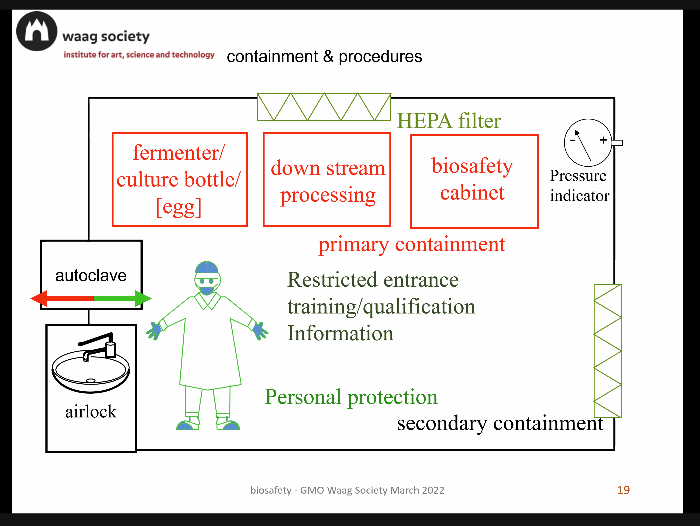2022/03/21 Mon
note
2022/03/21 Mon
17:30- Local Session
Difference of “Laminar flow cabinet” vs “Fume hood” vs “Clean bench” vs “Sterile Hood”
Fume hood = ドラフトチェンバー:
Air flow from inside the room to inside the bench.
“Laminar flow cabinet” = “Clean bench” = “Sterile Hood” = クリーンベンチ
Air flow is from inside the bench to inside the room.
ref:
https://lab-brains.as-1.co.jp/article/selection-guide/2021/08/2576/
18:30- Guest Lecture: Bioartistic Research: Lichen Adriana Knouf
XENOLOGY:
Scientific Research on Extraterrestrial Life
Classification of Lichen(地衣類):
crustose/foliose/fruticose
Lichens have both asexual and sexual reproduction.
ref
Queer Theory for Lichens
https://core.ac.uk/download/pdf/235683163.pdf
21:30- Lecture: Biology Basics Kas Houthuijs
→ Rescheduled to Biosafety Lecture by Per Staugaard
The Kas lecture will be held on the 22nd at 18:00-.
- Biosafety
- Risk groups
- Safe workshops ‘SMT’ rules
- GMO and the Dutch law
Biosafety
Definition fromWHO
“Laboratory Biosafety” is the term used to describe the contaminant principles, technologies and practices, that are implemented to prevent unintentional exposure to pathogens and toxins or their accidental release into the environment.
cf. )実験室バイオセーフティ指針−第3版
https://www.who.int/csr/resources/publications/biosafety/Biosafety3_j.pdf
Without biosafety, in addition to contamination within the lab (workers), contamination outside the lab, such as pandemics(population) and environmental damage, could occur.
ex) polio epidemic
Biological agents and risks
The danger of a biological agent is influenced by numerous factors such as:
- Pathogenicity
- Spread to the community
- Infective dose
- Availability of effective therapeutic treatment or vaccine
The skin is an important organ that protects the body from pathogens.
Biological risk groups
European Economic Community (DIRECTIVE 93/88/ECC, Oct. 1993)
(1) Group 1 biological agent means one that is unlikely to cause human
disease;
(2) Group 2 biological agent means one that can cause human disease and might be a hazard to workers; it is unlikely to spread to the community; there is usually effective prophylaxis or treatment available;
大概治るやつ
(3) Group 3 biological agent means one that can cause severe human disease and present a serious hazard to workers; it may present a risk of spreading to the community, but there is usually effective prophylaxis or treatment available;
(4) Group 4 biological agent means one that causes severe human disease and is a serious hazard to workers; it may present a high risk of spreading to the community; there is usually no effective prophylaxis or treatment available.
エボラとか治療法がなく死に至るやつ
AIDS is categorized as Group 3 or Group 2 depending on the country, although there is no definitive cure.
In Japan, 国立感染症研究所病原体等安全管理規定 are generic.
https://www.niid.go.jp/niid/ja/from-biosafe/8136-biosafe-kanritaikei.html
Bio-Occupational Health strategy
- Source:: Change material: safer strain [biological containment]
- Technical measures:: Containment
- Organization:: Training, SOPs(standard operation procedures), access control
- Hygiene:: Hand wash: prevent spreading in environment
- PPE:: Coat/gown, gloves, glasses, respirator,…
- Vaccination:: necessary & sufficient
- PEP(▪ Post exposition prophylaxis):: very much dependent on organism
Level 3 Layout

Wet-Lab SOPs(Standard Operating Procedures)
Safe Microbiological Techniques
- Doors and windows be closed during all work
- Workspace be kept clean and tidy
- Decontamination of work area after work
- Cleaning directly after a spill
- All personnel be trained [qualified]
- Dedicated and suitable working clothes
- No jewellery on hands and arms
- Nails be kept short
- No loose hair
- No open shoes
- No mobile telephones
- No eating and drinking on the lab
- No contact between hands and face
- Hands be washed after work
- No pipetting by mouth
- Avoid aerosol formation
- Glassware and equipment be disinfected
- Transport of contaminated materials in closed containers
- Administration kept separately from microbiological work
Make sure to close the front of your lab coat.
In some cases, short sleeves are more appropriate.
Label everything
Labels must consist of:
Content, Date, Name
NFPA safety diamond
NFPA 704:化学薬品の危険性を表示するための規格、全米防火協会(NFPA)が策定・管理。
https://ja.wikipedia.org/wiki/NFPA_704
biohazard mark
MSDS (Material Safety Data Sheets)
- Procedures for safe handling [including PPE]
- Physical Data
- Melting point
- Boiling point
- Toxicity
- Reactivity
- Storage
- First aid procedure
Waste disposal
Think of how to dispose of things before you bring it into the lab.
Biological materials: disposed in special bin “infective material”
Decontamination by heat: boiling or even autoclaving
Definition of a biological agent
“Any microorganism, including genetically modified, cell culture or endoparasite”
Biological Waste
You are responsible for killing anything you grow:
- Kill of any culture with 10% hypochlorite bleach(freshly prepared)
- Incubate for 16h before disposal
- Clean any used surface and object with 70% ethanol (red capped bottles)
- Autoclave for 20 minutes
Broken glassware
- Do NOT dispose in the normal trash bin
- Special “broken glass” container
- Use broom to clean up, because you can easily cut yourself
Chemical waste
- Check what is allowed to store in the lab with the labmanager
- Check what is allowed to go down the sink with the labmanager
- Do NOT mix / bomb guide:
- Concentrated Acids and Bases
- Oxidizers and Flammables
- Water reactive substances and aqueous solutions
- Cyanides and acids => cyanide gas
- Bleach and acids => chloride gas
- Search for reactivity on the internet!
- Read the MSDS before using a chemical!
GMO & legislation
- EU directive 2009/41/EG ‘contained use of GMO’
- Translated into national legislation
- Wet milieugevaarlijke stoffen
- Besluit GGO
- Regeling GGO
- Obligatory permit or notification
- Waag society obtained the first S-I ‘permit’
- BVF [ biosafety officer] as supervisor
- Februari 2022 ML-1 notification
